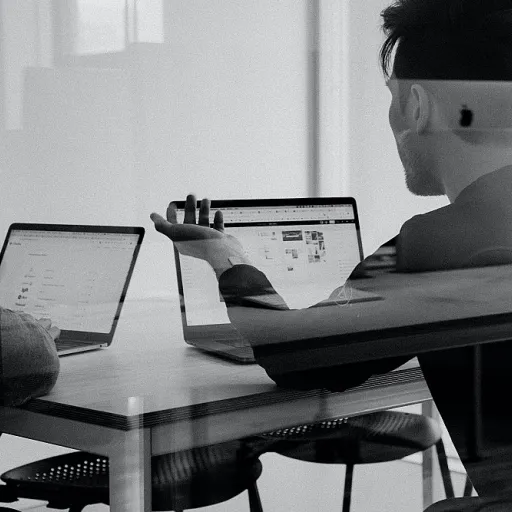
Understanding Sciatic Pain in the Workplace
Unraveling the Discomfort: Sciatic Pain at Work
In the dynamic workplace environment of the Arabian Emirates, many employees spend extended hours seated, leading to discomfort and pain, notably sciatic nerve discomfort. This condition, often exacerbated by long sitting periods on subpar desk chairs, can significantly impair professional productivity. Understanding how office setups contribute to this issue is crucial in formulating effective solutions.
Sciatica, characterized by pain that follows the sciatic nerve pathway from the lower back down to the legs, can be intensified by improper seating. Many standard office chairs lack adequate lumbar support and adjustability in seat depth, which are essential features for reducing nerve pressure and promoting a healthier seating posture.
An increasing number of businesses now prioritize employee welfare by investing in ergonomic products, such as chairs with adjustable lumbar support. These chairs, designed with breathable mesh and memory foam seat cushions, aim to provide comfort by alleviating pressure points, thus offering significant pain relief.
Our analysis sheds light on the importance of an appropriately designed office chair for sciatica pain. By focusing on ergonomic standards and utilizing recycled materials, companies can enhance both user satisfaction and sustainability.
Key Features of an Ergonomic Chair
Essential Characteristics to Look for in a Chair
When choosing an office chair, several key features can make a significant difference in minimizing pain and enhancing comfort. A quality chair should provide optimal support, especially for those experiencing sciatica. Here’s what to keep in mind:- Ergonomics: A chair designed with ergonomic principles integrates various elements that promote alignment and reduce strain on the body. Ergonomic office chairs focus on adjusting to the body’s natural form to alleviate pressure on the sciatic nerve.
- Adjustable Lumbar Support: Supporting the lumbar region can help distribute weight evenly along the spine and reduce tension. Look for chairs that offer adjustable lumbar support to cater to individual needs.
- Seat Cushion and Depth: Consider chairs with cushioned seats made from memory foam or similar materials that retain their shape, as this offers comfort during long sitting periods. A seat with adjustable depth further customizes the chair to fit your body.
- Breathable Mesh: A chair with a mesh back promotes airflow, keeping you cool and comfortable. This feature is particularly beneficial in the hot climate of the Arabian Emirates.
- Recycled Materials: Environmentally conscious products use recycled materials, which can be both innovative and sustainable while meeting ergonomic and quality standards.
- Adjustability: The best office chairs offer multiple adjustment options including height, armrests, and tilt tension, allowing for a personalized fit that adapts to various body shapes and sizes.
Impact of Chair Design on Productivity
The Role of Chair Design in Enhancing Workplace Efficiency
Finding the most suitable office chair goes beyond aesthetics; it directly influences productivity. The modern office environment demands ergonomic chairs meticulously designed for optimal support and functionality. Choosing the ideal chair ensures comfort, especially for employees facing challenges like sciatica. An ergonomic chair is designed with key features to relieve pressure and promote comfort. Lumbar support is crucial, as it targets the lower back area where sciatic nerve pain often originates. More advanced models offer adjustable lumbar support, which can be tailored to each user's specific needs. The importance of seat depth cannot be underestimated. An appropriate seat depth accommodates a range of body types, allowing feet to rest flat on the floor while the back maintains support. Additionally, the seat cushion’s quality, such as memory foam, can alleviate sciatic pain by reducing pressure points. Materials like breathable mesh are popular due to their capacity to maintain temperature and ventilation, resulting in a fresh seating experience during long sitting hours. Chairs made of recycled materials are gaining traction as environmentally-conscious choices without compromising on support or design standards. Investment in high-standard office chairs is justified by the enhanced performance and decreased incidence of discomfort-related absenteeism. When office managers select chairs with ergonomic features, productivity improves, and employees work more efficiently. For more on why selecting the right ergonomic chair is vital for office productivity, visit Exploring the Benefits of Famis 360 for Office Managers in the Arabian Emirates. Considering these design elements when selecting chairs can make a significant difference, as demonstrated by practical insights from successful Arabian Emirate companies.Selecting the Right Chair for Your Office
Finding the Perfect Chair for Your Work Space
Selecting the right office chair to help alleviate sciatica pain is crucial for creating a comfortable and productive work environment. Given the prevalence of sciatic nerve discomfort among office workers, it is essential to focus on both comfort and functionality when choosing an ergonomic office chair. An effective chair should offer comprehensive lumbar support, ideally through an adjustable lumbar feature that contours to the natural curvature of the spine. This adjustment helps in reducing pressure and pain associated with prolonged sitting. Memory foam seat cushions and breathable mesh can also enhance comfort during long hours at the desk by promoting airflow and dissipating heat. Consider chairs that adhere to ergonomic standards while offering versatility in features such as seat depth, armrest height, and backrest inclination. Adjustability can make a significant difference in providing tailored support and improving posture, ultimately reducing sciatica-related pain. When pondering over available products, weigh factors like material and durability. Some companies opt for office chairs made from recycled materials, combining sustainability with functionality. Moreover, checking the product's price against its features ensures that you are making an informed purchase that aligns with your office needs. Popular choices include a black ergonomic office chair design, which combines style with the necessary support. However, it’s important to recognize that the best chair for one individual may not be the best for another, so personal trial and testing play pivotal roles in decision-making. With a wide range of standard and innovative designs available, investing time in selecting the right ergonomic chair will result in improved comfort and potentially significant pain relief, contributing to a healthier work atmosphere.Case Studies from Arabian Emirate Companies
Insights from Arabian Emirate Companies
The Arabian Emirates, known for their success in various industries, also emphasize the importance of ergonomic office environments. Several leading companies in the region have adopted ergonomic solutions to combat sciatic pain and improve employee productivity. By strategically choosing ergonomic office chairs, these companies have effectively integrated key features like adjustable lumbar support, which aids in alleviating sciatic nerve discomfort.
Through comprehensive evaluations, companies have recognized the impact of specific features such as breathable mesh backrests and memory foam seat cushions. These features contribute significantly to reducing pressure and enhancing long-term seating comfort. Moreover, the inclusion of adjustable seat depth options allows for personalization, ensuring each employee receives tailored support for their unique needs.
The transition to ergonomic chairs has been complemented by the incorporation of products made from recycled materials, aligning with both eco-friendly standards and lasting durability. This consideration not only enhances the company’s corporate social responsibility but also reflects a cost-effective approach given the competitive price range of these office chairs.
The adoption of ergonomic products has proven beneficial beyond pain relief, as it is directly linked to enhanced employee satisfaction and productivity. Companies have reported noticeable reductions in absenteeism caused by back and sciatic pain, signifying an encouraging trend towards healthier work environments. These findings highlight the strategic advantage of investing in ergonomic office solutions, setting a standard across industries in the Arabian Emirates.
Tips for Maintaining a Healthy Work Environment
Ensuring a Supportive Work Environment
Maintaining a healthy work environment is crucial in mitigating the discomfort associated with prolonged sitting and sciatica pain. Implementing a few practical strategies can significantly enhance employee well-being, leading to increased productivity and job satisfaction.
- Regular Movement Breaks: Encourage employees to take regular breaks to stand, stretch, or take short walks. This can help reduce pressure on the sciatic nerve and improve circulation.
- Correct Posture Awareness: Educate staff on maintaining proper posture with ergonomic chairs and seating arrangements that provide adequate lumbar support, reducing the risk of compression on the sciatic nerve.
- Ergonomic Assessments: Conduct regular ergonomic assessments to ensure that office chairs and desks meet ergonomic standards. Adjust features like seat depth and adjustable lumbar support to suit individual needs.
- Quality Office Chairs: Invest in high-quality ergonomic office chairs with breathable mesh, memory foam seat cushions, and adjustable lumbar support. Opting for chairs from recycled materials can also align with sustainable office practices.
- Variety in Workstations: Provide varied workstations, such as standing desks alongside ergonomic office chairs. This offers employees the option to alternate between sitting and standing, alleviating pressure on the sciatic nerve.
By adopting these strategies, Arabian Emirate companies can create a work environment that not only supports employees' physical health but also fosters a culture of care and productivity. Ensuring that ergonomic principles are a standard in office design can result in long-term benefits, both in health and in business outcomes.













